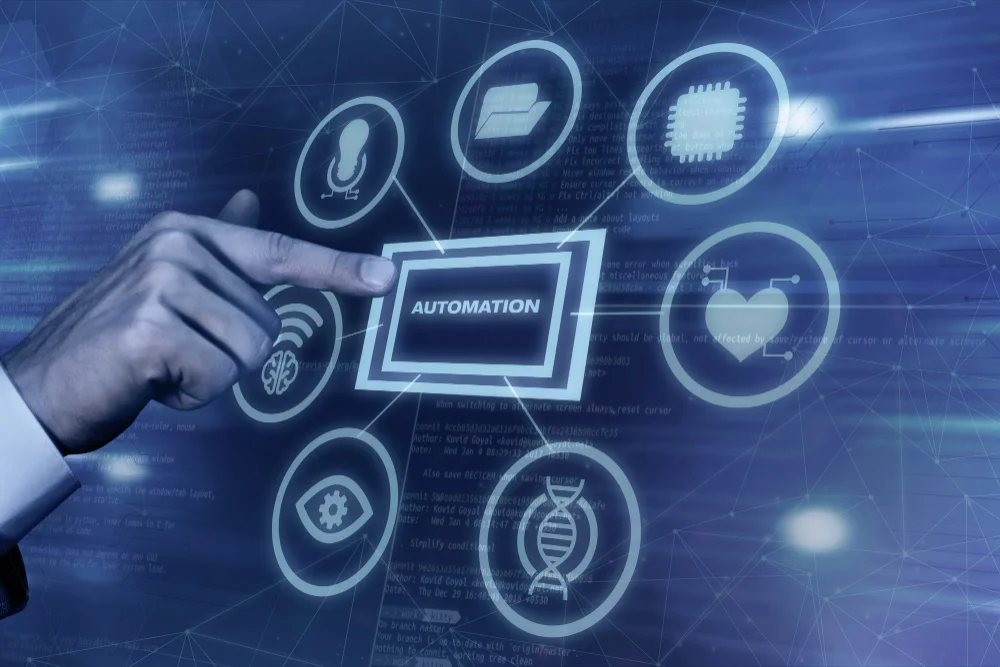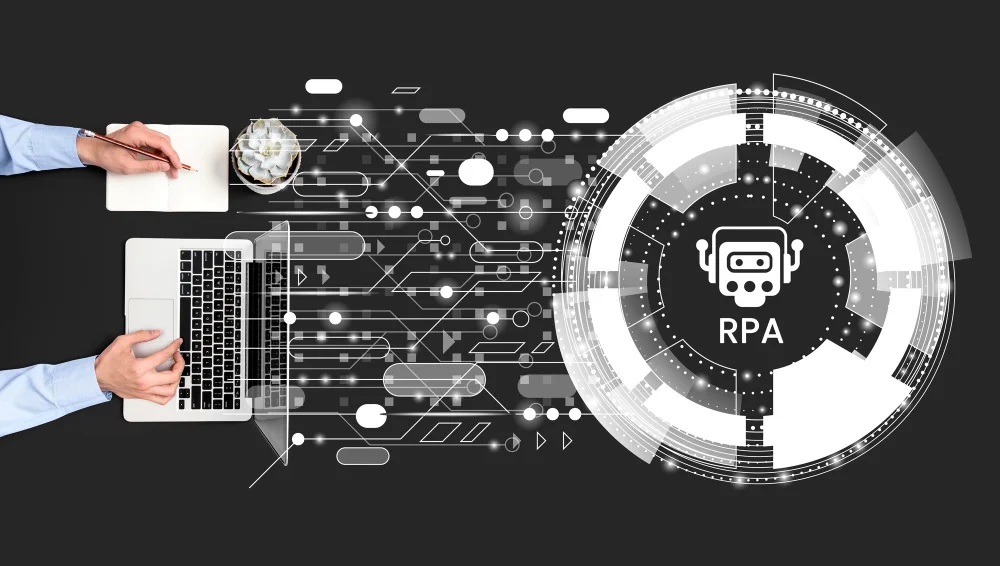Robotic Process Automation (RPA) is the game-changer businesses need to stay ahead in an increasingly competitive landscape.
Why?
By automating repetitive tasks and streamlining workflows, RPA empowers companies to:
- Operate more efficiently,
- Reduce costs, and
- Deliver better outcomes.
Therefore, this technology isn’t just a buzzword, it’s a powerful tool transforming how businesses function and thrive.
Statistics support this claim as well:
- Forrester Research predicts that the RPA market will reach $22 billion by 2025, reflecting its rapid adoption across industries.
- According to a recent Deloitte survey, 53% of organizations have already started their RPA journey, and this is expected to rise to 72% within the next two years.
These stats highlight the growing reliance on automation as a key driver of business success.
In this RPA Guide, we’ll break down everything you need to know about RPA, from its definition to the benefits it brings and how you can implement it effectively. So, let’s jump right into it.

What is Robotic Process Automation?
Robotic Process Automation (RPA) is a technology that allows businesses to automate repetitive, rule-based tasks using software bots. Unlike traditional automation, which requires complex coding, RPA uses bots to interact with digital systems like a human—clicking, typing, and navigating.
These bots are created using RPA tools, which provide a platform for designing, managing, and deploying bots across an organization.
Typically, RPA tools include drag-and-drop interfaces and pre-built connectors to simplify bot development. Once programmed, these bots can execute tasks such as:
- Data entry,
- Processing transactions, and
- Responding to customer queries, all without human intervention.
Moreover, there is a huge difference between traditional automation and Robotic Process Automation. Traditional automation often involves integrating systems through APIs or custom coding. In contrast, RPA is non-intrusive; it works on the front end of applications and mimics human actions, making it much easier to implement and scale.

What are the Benefits of Robotic Process Automation?
Robotic Process Automation (RPA) offers a range of benefits that make it a strategic investment for businesses looking to optimize their operations. Let’s explore some of the key RPA benefits and why it’s becoming essential for modern enterprises.
- Increased Efficiency and Productivity
One of the primary benefits of Robotic Process Automation is its ability to boost efficiency and productivity. By automating repetitive and time-consuming tasks, RPA allows employees to focus on more strategic activities that require human judgment and creativity.
For example, while RPA bots handle data entry and report generation, your team can dedicate time to decision-making and innovation. Thus, this shift not only accelerates processes but also maximizes the output of your workforce.
- Cost Reduction and ROI
Another significant advantage of RPA is cost reduction. Implementing RPA can lead to substantial savings by reducing the need for manual labor and minimizing operational costs.
Since Robotic Process Automation bots work tirelessly without breaks, businesses can achieve higher throughput at lower costs.
Moreover, the ROI is often realized quickly, as RPA reduces the expenses associated with errors, rework, and inefficiencies. Furthermore, many companies report recouping their RPA investments within months, making it a financially sound choice.
- Error Reduction and Improved Accuracy
Robotic Process Automation shines when it comes to error reduction and improved accuracy. Unlike humans, who are prone to fatigue and mistakes, RPA bots perform tasks with consistent precision.
This is particularly beneficial in data-intensive processes where accuracy is critical, such as financial transactions, compliance checks, and customer data management.
Therefore, by minimizing errors, RPA not only saves time but also enhances the quality of outputs, leading to better decision-making.
- Scalability and Flexibility in Business Processes
Scalability is another key benefit of Robotic Process Automation. As business needs evolve, RPA systems can be easily scaled up or down to match demand. RPA allows you to easily scale bots up or down as needed, without making major changes to your existing infrastructure.
This adaptability allows businesses to respond swiftly to market changes, new opportunities, and seasonal fluctuations. Thus, ensuring that operations remain efficient and responsive.

Key Considerations When Implementing RPA
Implementing Robotic Process Automation (RPA) can revolutionize your business, but a strategic approach is essential. Here are key considerations to keep in mind:
Identifying Processes Suitable for Automation
- Firstly, focus on repetitive, rule-based, and high-volume tasks.
- Ideal candidates include data entry, invoice processing, and customer service tasks.
- Moreover, ensure processes are standardized before automating.
- Use tools or consult with experts like advansappz to accurately identify processes with the highest potential for RPA.
Challenges in RPA Adoption and How to Overcome Them
- Employee Resistance: Address fears of job displacement by highlighting how RPA frees employees from mundane tasks, allowing them to focus on more strategic work.
- Bot Failures: Bots can fail if underlying processes change. Therefore, regular monitoring and updates are essential to maintain their effectiveness.
- Scalability Issues: Start with a pilot project to test Robotic Process Automation on a smaller scale before full deployment.
- Governance: Lastly, establish strong RPA governance to manage bot performance and adjust to any changes in processes.
Best Practices for Successful RPA Implementation
- Develop a Clear Roadmap: Firstly, outline your RPA goals and the specific processes you plan to automate.
- Involve Stakeholders Early: Engage all relevant stakeholders from the start to ensure buy-in and address concerns.
- Start Small and Scale: Begin with a pilot project to refine your approach before expanding RPA across the organization.
- Continuous Training: Furthermore, invest in ongoing training and support to keep up with technology updates and changes in processes.
- Partner with Experts: Collaborate with advansappz for a seamless Robotic Process Automation journey. They offer comprehensive support from strategy to deployment. Thus, ensuring your RPA implementation is optimized for success.

How advansappz Helps with RPA Implementation
Partnering with the right experts can make all the difference in a successful RPA implementation. advansappz brings industry knowledge, technical expertise, and a client-focused approach to help businesses seamlessly integrate RPA into their operations.
Here’s how advansappz can assist in driving your RPA initiatives forward:
- Process Assessment: Identifies the best candidates for automation to maximize ROI.
- Customized Solutions: Designs tailored Robotic Process Automation strategies that align with your business goals.
- End-to-End Support: Manages the entire implementation process from planning to deployment.
- Expert Guidance: Provides expert consultation on best practices and overcoming challenges.
- Ongoing Maintenance: Offers continuous support and updates to ensure optimal RPA performance and scalability.
The Future of RPA
Robotic Process Automation (RPA) is not just about automating repetitive tasks, it’s evolving rapidly and becoming more intelligent.
One of the biggest trends in RPA is the integration of Artificial Intelligence (AI) and Machine Learning (ML), which is leading to the rise of intelligent automation. This fusion allows RPA to handle more complex processes, such as decision-making and predictive analytics.
As a result, this makes it a powerful tool in digital transformation strategies.
Moreover, as businesses continue to adopt RPA, we can expect significant advancements in RPA technology.
For instance, future RPA solutions will likely feature enhanced cognitive capabilities, enabling bots to learn from data, adapt to new scenarios, and improve over time.
Additionally, the use of cloud-based RPA platforms is expected to grow, offering more flexibility and scalability for businesses of all sizes. These developments are set to push RPA beyond its current capabilities, making it indispensable for driving efficiency and innovation.
Conclusion
Robotic Process Automation (RPA) holds immense potential to transform business processes by enhancing efficiency, reducing costs, and minimizing errors. As we’ve explored, RPA goes beyond simple task automation, it offers a strategic advantage by freeing up valuable human resources. Moreover, it also enables businesses to scale operations effortlessly.
For CEOs and managers, the opportunities with RPA are vast, making it an essential tool for modernizing and optimizing your organization.
So, if you’re ready to explore how RPA can revolutionize your business, now is the time to take action. Additionally, advansappz is here to help you every step of the way. Contact advansappz today to begin your journey towards a more efficient, automated future.
FAQs
- What industries can benefit the most from Robotic Process Automation?
RPA is highly versatile and can benefit a wide range of industries, including finance, healthcare, manufacturing, retail, and customer service.
- How long does it typically take to implement RPA in an organization?
The timeline for RPA implementation varies depending on the complexity and scale of the project. A basic Robotic Process Automation software can be deployed in a few weeks, while more complex, organization-wide implementations might take several months.
- What are the common costs associated with RPA implementation?
Costs can include software licensing, infrastructure setup, development, integration, and ongoing maintenance. Moreover, the total investment depends on the number of bots, the complexity of processes, and the need for customization.
- How does RPA handle exceptions or unexpected scenarios?
Robotic Process Automation bots are designed to handle routine tasks, but they can struggle with exceptions or changes in processes. Additionally, advanced RPA solutions integrate AI and ML to improve decision-making and adapt to unexpected scenarios more effectively.
- Can RPA integrate with existing IT systems and applications?
Yes, RPA is designed to work across various systems and applications without the need for extensive integration or changes to existing infrastructure. Therefore, this allows Robotic Process Automation to interact with legacy systems, cloud applications, and more, making it highly flexible.












